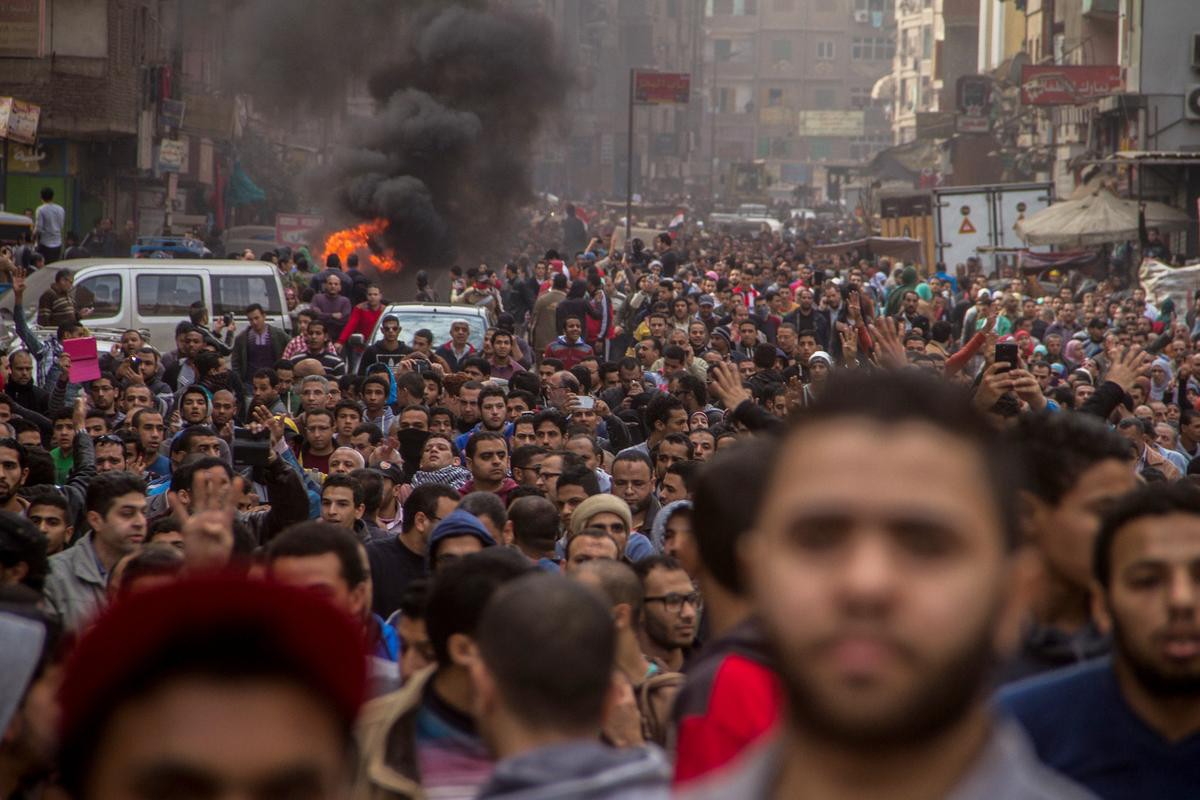The case of Egypt: What does a counter-revolution look like?

Anyone who saw the photo taken minutes after Shaimaa al-Sabbagh was shot would realise how eerie, surreal and symbolic the tragedy is. In the photo, one can see people walking past Shaimaa, incurious, as her blood spills over her face.
Only Shaimaa’s friend, first thought to be her husband, is seen in the photo carrying her as she bleeds. The rest of the people in the photo are indifferently going on with their lives.
Even in such a photo, the counter-revolution is reflected. The social condition in which the disruption of the public sphere becomes implausible is a direct outcome of a counter-revolutionary regime. No matter how the revolution teases the structures of the state, the mechanisms of control and discipline remain intact.
The term “counter-revolution” is considered to be abstract. Within that abstraction, the discussion on the military intervention and detainment of Egyptian President Morsi in July 2013 is a vicious circle: was it a “correction” of the 25 January Revolution – as Sisi puts it? Or was it a military coup?
But the counter-revolution is not really abstract. The counter-revolution manifests itself clearly in state bureaucracies and policies. The counter-revolutionary structures of the state operate in a manner that impedes the revolutionary process and opposes the initial demands of the revolution.
Simply put, whatever hinders revolutionary progress towards achieving the ideals of the revolution – bread, freedom, social justice – is counter-revolutionary. There is no abstraction in that.
In the pursuit of demystifying the counter-revolution in Egypt, three aspects can be considered: the policies of the counter-revolution, the political economy of the counter-revolution, and the discourse of the counter-revolution.
The policies of the counter-revolution
In preparation for Sisi’s reign, a “deeply restrictive” assembly law was passed. The law is known as the anti-protest law as it gives security officials the discrete privilege of banning any protest with little, if any, excuse needed.
The same law allows the Interior Ministry - seen as the hub of state violence and brutality - the right to shut down any meeting of more than 10 people in a public place.
Such laws are attempts to reinstall pre-revolution disciplinary rules on the Egyptian people. The bargain, as the regime justifies it, is security and economic growth in return for public passivity.
But neither security seems within reach nor does economic growth seem to materialise in favour of the ordinary Egyptian. Above all, the failing state-sponsored bargain has left numerous prominent activists and revolutionaries in prison.
The political economy of the counter-revolution
The institutionalisation of the counter-revolution goes beyond undemocratic policies. It also manifests itself in the economy of the state. In less than a year in power, Sisi received an estimated $20bn from regional and international powers, mainly Gulf States and the US.
The late Saudi King Abdullah implicitly revealed how Saudi aid is linked to Saudi demands from Egypt, most of which served to tighten the grip of the Egyptian regime over society and a return to pre-Arab Spring status.
For instance, Abdullah pushed for the release of Mubarak at a time when Saudi Arabia was preparing $10bn of economic relief to Egypt.
Also, the popular plea for “bread” in the Egyptian Revolution is now a distant echo as Sisi has endorsed strict austerity measures suggested by the IMF and the World Bank.
While the Egyptians struggle to survive the decrease in state subsidies, workers' unions across industries are gaining momentum and strikes are becoming frequent. But Sisi’s austerity remains unaffected, Mubarak’s sons are released, revolutionaries are on hunger strikes in prison, and the money is still flowing in to serve the counter-revolution.
The discourse of the counter-revolution
Last week, an audio recording, allegedly from the office of the Egyptian president was leaked. The phone conversation exposes the way in which high profile media figures were literally instructed by the military regime on how to support Sisi’s bid for presidency.
Even before the conspiracy was exposed, the quality of news coverage and media ethics in Egypt was known to have reached a new low. It was obvious by then that the Egyptian media goes with the flow of power and the Egyptian public is being bombarded with state-sponsored propaganda on TV as well as in the newspapers.
In a systematic process, the initial revolution has been framed as legit but flawed and the military coup has been represented as a corrective initiative by the military under the consent of the people that saved the country from a disaster.
Even the anniversary of the revolution was turned into a tragedy as the security forces shot and killed 16 protesters who attempted to take the streets on 25 January, 2015.
The despicable act of revolt
The Egyptian regime has managed to survive the first wave of the Egyptian Revolution. The military remains the biggest owner of capital in the Egyptian economy. It remains the most powerful institution, unaccountable and in absolute power.
The Egyptian people, weary after years of chaos and economic trouble, seem to have accepted the failing state-sponsored bargain of security and growth. Although the counter-revolution has maintained monopoly over coercive violence, courageous revolutionaries like Shaimaa remain a frequent disruption to the flow of the counter-revolution.
There is a chance that one day the Egyptians will walk on the cracked sidewalks of Cairo and see Shaimaa, the lack of bread, the lack of freedom, and the lack of social justice. Until then, may revolution long live “outside history”.
- Ibrahim Halawi is a London-based researcher and a PhD candidate at Royal Holloway University of London. His research focuses on power dynamics and counter-revolution in the Arab World. He has published contributions on Political Islam in the context of the Arab Spring and the geopoliticial challenges to secularism in the Arab World. Also, he founded a secular student-run newspaper in Lebanon.
The views expressed in this article belong to the author and do not necessarily reflect the editorial policy of Middle East Eye.
Photo: Protesters mark the fourth anniversary of the Egyptian revolution (AA)
The views expressed in this article belong to the author and do not necessarily reflect the editorial policy of Middle East Eye.
Photo credit: An Egyptian flag flies from a statue in Cairo's Tahrir Square in 2011 (AFP)
- See more at: http://www.middleeasteye.net/columns/egypts-25-january-uprising-four-years-371667276#sthash.hqg1TIAK.dpufThe views expressed in this article belong to the author and do not necessarily reflect the editorial policy of Middle East Eye.
Photo credit: An Egyptian flag flies from a statue in Cairo's Tahrir Square in 2011 (AFP)
- See more at: http://www.middleeasteye.net/columns/egypts-25-january-uprising-four-years-371667276#sthash.hqg1TIAK.dpufNew MEE newsletter: Jerusalem Dispatch
Sign up to get the latest insights and analysis on Israel-Palestine, alongside Turkey Unpacked and other MEE newsletters
Middle East Eye delivers independent and unrivalled coverage and analysis of the Middle East, North Africa and beyond. To learn more about republishing this content and the associated fees, please fill out this form. More about MEE can be found here.





